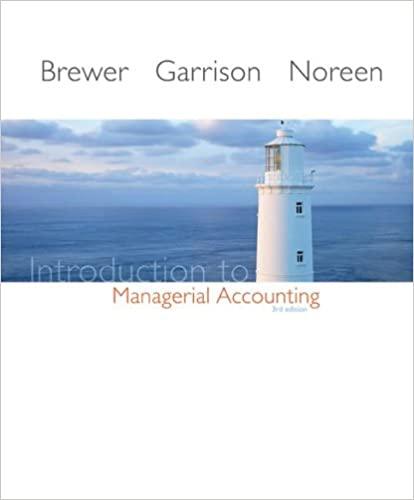Hunter Corporation uses activity-based costing to determine product costs for external financial reports. At the beginning of
Question:
Hunter Corporation uses activity-based costing to determine product costs for external financial reports. At the beginning of the year, management made the following estimates of cost and activity in the company's five activity cost pools:
Activity Cost Pool Labor related Activity Measure Direct labor-hours Estimated Overhead Cost $270,000 S60,000 $180,000 $320,000 S840,000 Expected Activity 30,000 DLHs 750 orders 1,200 receipts 8,000 relays 60,000 MHs Production orders Material receipts Relay assembly General factory Number of orders Number of receipts Number of relays Machine-hours Required:
1 Compute the activity rate (i.e.. predetermined overhead rate) for each of the activity cost pools.
2. During the year, actual overhead cost and activity were recorded as follows:
Activity Cost Pool Actual Overhead Cost Labor related S 279,000 Production orders 58,000 Material receipts 1 90,000 Relay assembly 320,000 General factory 847,000 Total overhead cost S1 ,694,000 Actual Activity 32,000 DLHs 700 orders 1 ,300 receipts 7,900 relays 61,000 MHs
a. Prepare a journal entry to record the incurrence of actual manufacturing overhead cost for the year (credit Accounts Payable). Post the entry to the company's Manufacturing Overhead T-account.
b. Determine the amount of overhead cost applied to production during the year.
c. Prepare a journal entry to record the application of manufacturing overhead cost to Work in Process for the year. Post the entry to the company's Manufacturing Overhead T-account.
d. Determine the amount of underapplied or overapplied manufacturing overhead for the year.
3. The actual activity for the year was distributed among the company's four products as follows:
Activity Cost Pool Product A Labor related (DLHs) 8,000 Production orders (orders) 1 60 Materials receipts (receipts) 1 00 Relay assembly (relays) 2,700 General factory (MHs) 1 3,000 Actual Activity Product B Product C Product D 1 1 ,000 4,000 9,000 200 130 210 460 240 500 5,200 18,000 14,000 16,000.
a. Determine the total amount of overhead cost applied to each product.
b. Does the total amount ofoverhead cost applied to the products above tie in to the T-accounts in any way? Explain.
Step by Step Answer:

Introduction To Managerial Accounting
ISBN: 9780073048833
3rd Edition
Authors: Peter Brewer, Ray Garrison, Eric Noreen





